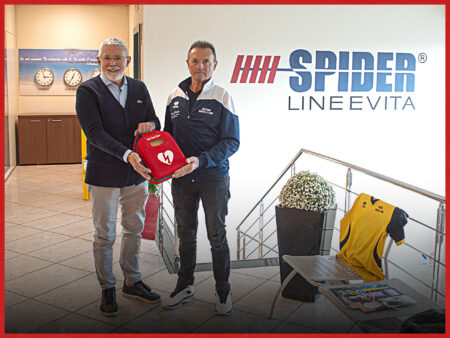Summer heat waves can be dangerous to health and productivity. When temperatures rise in unusual ways compared to seasonal averages, the human body has to work hard to thermoregulate itself. If you’re not careful, prolonged exposure to heat can cause unpleasant symptoms such as dizziness, nausea, muscle cramps, and even heat stroke.
As a worker, it is important to protect yourself and your colleagues during periods of intense heat. By following a few simple precautions, you can ensure everyone’s safety and keep productivity high. This guide will provide you with practical advice for hydration, rest, appropriate clothing and managing the work environment so that you can focus on your work without jeopardizing your health. Get ready for summer and learn how to deal with extreme heat effectively. Your health and your work will thank you.
To recognize the risks of high temperatures, it is important to know the signs of overheating and heat stroke.
If you experience these symptoms or those of a colleague, seek medical attention immediately. In the meantime, move to a cool, shady place, hydrate, refresh and rest. High temperatures can be deadly, so don’t take these signals lightly.
To prevent exposure to dangerous temperatures, schedule strenuous activities in the cooler hours of the day, wear breathable and light clothing, drink plenty of water and take frequent breaks in shady places. Your health and productivity depend on your ability to recognize the risks of heat and take precautions.
When temperatures rise, the risk of dehydration and heat stroke increases dramatically. It is crucial to recognize the signs of these health hazards to protect yourself and your colleagues.
Taking precautions against these hazards will help maintain productivity and ensure the safety of all workers during periods of intense heat.
To safeguard health and productivity during work in extreme heat, several preventive measures must be taken.
Drinking plenty of water is essential to replenish fluids lost through sweating. Aim to drink 6-8 ounces of water every 15-20 minutes. In addition to water, consume electrolyte drinks or fruit-infused water to replenish salts and minerals.
Working in intense heat can lead to heat-related illnesses such as heat exhaustion or heat stroke. Take regular breaks in an air-conditioned environment. Every 45-60 minutes of intense activity, take a break of 10-15 minutes.
Lightweight, loose and breathable clothing, made from natural, breathable fibers such as cotton, allows maximum airflow and cooling. Avoid dark colors that absorb more heat.
Products such as refreshing towels, wristbands and tank tops provide relief from high temperatures. Before using them, put them in the refrigerator or freezer to get maximum cooling.
-Cooling hand dryers: They can lower the skin temperature by up to 30 degrees Fahrenheit. Wrap around the neck, shoulders or rest on the head.
-Refreshing wristbands: They work by cooling the pulse points of the wrists. They can lower body temperature for up to 2 hours.
-Cooling vests: Jacket lined with cold compresses or cooling crystals that you wear under clothing to lower your central body temperature. It can cool down to 4 hours, depending on the model.
-Portable fans: Battery-powered manual fans generate a refreshing breeze, pointing the fan at pulsation points such as the neck, wrists and ankles.
In extreme heat, take extra measures to avoid overheating, such as limiting strenuous activities or exercises, using refreshing products and staying in an air-conditioned environment as much as possible. Pay attention to heat warnings issued by local health departments and follow the recommendations provided. Safety during heat requires vigilance and a proactive approach to managing heat-related risks.
When working in conditions of intense heat, it is essential to take frequent breaks and rest. The human body produces heat during physical and mental activity, which can quickly bring your body temperature to dangerous levels if you don’t take a break to allow the body to cool down.
Taking frequent breaks, staying hydrated and getting more rest is the best way to protect your health and productivity when temperatures are high.
When it is very hot, it is essential to wear light, breathable and light-colored clothing. Clothes made of cotton, linen or other natural and fresh fabrics are ideal. Dark clothes absorb heat, so avoid dark-colored pants and shirts. Short-sleeved shirts, tank tops, shorts, and a light skirt are all great options.
Apply daily sunscreen with a sun protection factor (SPF) of at least 30 or higher, especially if you spend a lot of time outdoors. Look for a sunscreen that is resistant to water and sweat. Remember to protect not only your face but also your neck, shoulders, arms and any other exposed skin area.
A hat, especially a wide-brimmed one, provides shade and helps keep your head and body cool. A cap or bandana may also be helpful. Make sure that any headgear you choose is made of a breathable and fresh material such as cotton or linen.
Sunglasses with UV protection block harmful sun rays and protect your eyes from glare and sun damage. Look for oversized sunglasses that cover most of your face and eyes.
Depending on the type of activity or work performed, you may need to wear personal protective equipment (PPE) such as respirators, gloves, safety boots, etc. Make sure any PPE is designed for use in hot conditions and does not hinder perspiration or cooling of the body.
To reduce heat exposure in the workplace, adequate ventilation and airflow must be ensured. Open windows and use fans to circulate air, as stagnant and trapped heat can be dangerous. If possible, exhaust fans should expel warm air outside, while circulation fans improve indoor airflow. Employers must perform routine maintenance of HVAC systems and repair or replace non-functioning units immediately.
Air conditioning is one of the most effective methods of cooling workplaces and protecting workers from heat-related illnesses. In areas where temperatures regularly exceed 91°F (33°C), OSHA recommends setting up cooling centers or rest cycles at work. If air conditioning is not available, employees should take regular breaks in cooler, shadier areas.
Providing shade and shielding from direct sunlight or other heat sources can greatly lower temperatures in work areas. Install awnings, umbrellas or tree plants to block out sunlight, especially on the walls facing south and west. Shield or insulate hot equipment, such as ovens, to avoid exposure to radiant heat. Consider rescheduling jobs that require direct sun exposure or the use of heavy protective equipment at cooler times of the day.
Employers must make heat disease prevention a priority by providing adequate cooling, ventilation and shielding mechanisms in every work environment. Monitoring weather conditions and changing working hours or intensity during extreme heat events may also be necessary to avoid dangerous overexposure of employees. By taking proactive measures to control heat and limit heat exposure, companies can fulfill their responsibility to protect the health and safety of workers, even in high temperatures.
Working in hot conditions can be dangerous if you don’t take proper precautions. For those who engage in strenuous outdoor work with high temperatures, several measures must be taken to protect health and productivity.
Drinking plenty of water is essential to replenish fluids lost through sweating in hot weather. Keep water handy and drink small amounts frequently, about a glass every 15-20 minutes. Pay attention to signs of dehydration, such as increased thirst, dry mouth, dizziness, or dark urine.
Taking short breaks in shaded or air-conditioned areas is important to prevent overheating and heat-related illnesses. Every 45-60 minutes of intense work in the heat, take a break of 10-15 minutes. Use this time to rest, hydrate and refresh.
Lightweight, loose and breathable clothing, made with natural and breathable fabrics such as cotton, is best for hot conditions. Light clothing also helps to reflect the sun’s rays more. Be sure to wear a ventilated hat and sunglasses with UV protection.
Watch out for symptoms of heat-related illnesses, such as heat cramps, exhaustion or stroke. Heat cramps cause painful muscle spasms, usually in the legs or abdomen. Heat exhaustion can cause profuse sweating, nausea, dizziness, or weakness. Heat stroke is life-threatening and is indicated by elevated body temperature, confusion, rapid pulse, loss of consciousness or seizures. If heat stroke is suspected, seek medical attention immediately.
Whenever possible, schedule the most physically demanding activities in the coolest hours of the day, before 10.00 and after 18.00. The midday heat is often the most intense, so if you work outdoors, it is advisable to plan less strenuous activities during this period. Consider using fans or nebulizers to lower ambient temperatures for outdoor workers.
With proper precautions, working in hot conditions does not have to be dangerous. Staying hydrated, taking proper breaks, dressing appropriately, and paying attention to heat sickness are all important steps to protecting health and safety during strenuous activity in high heat conditions. Monitoring the heat index and adapting work programmes, if necessary, can also help minimise risks. It is crucial to take care of the well-being of all workers.
As an employer or safety manager, it is important to understand the risks associated with high temperatures and take steps to protect the health and productivity of employees.
Analyze working conditions to determine the level of risk of heat exposure. Consider air temperature, humidity, ventilation, the type of physical activity required and the use of protective clothing. High-risk activities include those outdoors or in uncooled environments.
Educate employees on the risks of high temperatures and preventive measures. Explain the importance of staying hydrated, taking more frequent breaks, and monitoring for signs of heat sickness. Provide guidance on emergency protocols in case of heat stroke.
Consider starting work earlier, reducing working hours or increasing breaks during the hottest periods of the day. These measures can reduce overall heat exposure and the risk of heat stress.
Increase natural or mechanical ventilation in the workplace. The use of fans and air conditioners can lower the perceived temperature by several degrees. Make sure that fresh air circulates and reaches all work areas.
Provide employees with unlimited access to fresh water and encourage them to drink regularly. Hydration is essential to prevent hyperthermia and maintain adequate cognitive and physical performance.
Recognize the warning signs of heat stress and take quick emergency measures in the event of heat stroke, such as immediately transporting the person to a cool place or shaded area.
The risk from high temperatures refers to the negative health and productivity effects due to exposure to excessive heat and humidity. When the temperature of the body rises, the thermoregulation system tries to maintain homeostasis by lowering body temperature through sweating. However, if the ambient temperature is too high, this cooling mechanism does not work efficiently and body temperature can rise to dangerous levels.
Symptoms of heat stroke include:
-Headache
-Nausea and vomiting
-Muscle cramps
-Fatigue and weakness
-Dizziness or fainting
-Confusion or irritability
-Rapid heartbeat
-Dry and warm skin
-Hallucinations (in severe cases)
Here are some tips to prevent the risk from high temperatures:
By following these tips, you can greatly reduce the health risks associated with high ambient temperatures.
Despite the high temperatures, you can continue to work efficiently and productively by taking a few simple precautions. Be sure to drink plenty of water to rehydrate your body, take frequent breaks to rest and take a deep breath, and wear light, breathable clothing. If you follow these tips, your skills and performance should not be affected by the heat. Even if temperatures rise, you can continue to be productive while maintaining your health and well-being. Take care of yourself and your work environment, and high temperatures shouldn’t hinder your productivity or success.
 Agevolazioni
Agevolazioni
 Events
Events